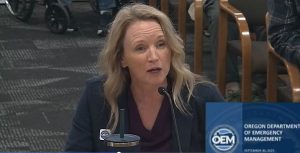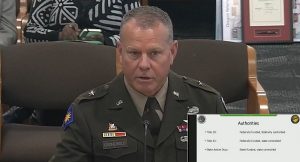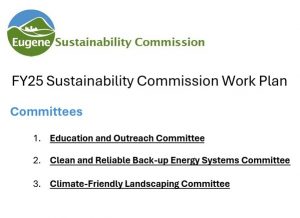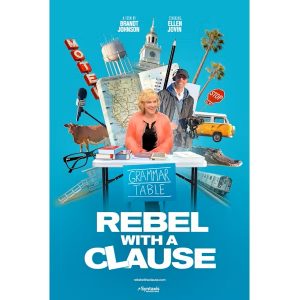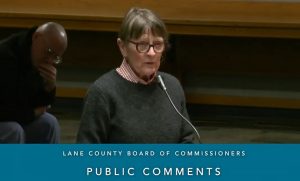At 50, Oregon Wild has become ‘Oregon Mild’
11 min read
by Mark Robinowitz
My name is Mark Robinowitz. I have been an advocate against herbicides since the 1980s, first in relation to organic food and agriculture, and since moving to Oregon a quarter century ago, I’ve been vocal about the forestry practice of aerial herbicides over corporate clearcuts.
This weekend the group Oregon Wild is having their 50th anniversary celebrations in Portland and Eugene. While I once celebrated their work to protect the remaining intact native old-growth forest of Cascadia, it’s been sad to see their slow decline, culminating in an outrageous sellout deal they and a dozen other groups made with Big Timber in February 2020 to acquiesce to continued aerial herbiciding over corporate clearcuts.
[00:00:58] The Private Forest Accord was negotiated in such secrecy that not even all their employees knew what was going on. The Oregon Wild employee who lived in the rural Coast Range next to aerial spray operations quit in disgust when he saw what his bosses had agreed to.
[00:01:17] Since 2020, it’s been difficult to find anyone who has not been paid to have an opinion for this deal. Most environmentalists who do not work for these groups have had little to no understanding of what was agreed to. And most are shocked when they learn about the details.
[00:01:36] I did hear of a friend of a friend who thought the deal was positive, but he was very elderly, not focused on the details. Apparently he liked the work that Oregon Wild did in its earlier, better days, when it was the Oregon Natural Resources Council. And his view was, anything they support must be good.
[00:01:59] The gap between image and substance enables a lot of toxic politics, not just with environmental groups undermining their goals in the pursuit of reasonableness and accommodation to power.
[00:02:12] This story is a sad example of how efforts to protect ecology and public health can degrade over the decades, especially as public relations become more important than actual accomplishment.
[00:02:25] Oregon Wild was formed as a courageous effort to protect the last old-growth forest, a very rare ecosystem that has some of the highest biomass density on the planet. Unfortunately, political success, compromise, the need for continued funding and ‘collaboration’ with the political party that runs Oregon has neutered this effort to the point the group, in alliance with a dozen others, made a grotesque example of ‘activist malpractice’ by surrendering to the timber companies that have been liquidating forests and then wrecking biodiversity and health by spraying them with herbicides.
[00:03:08] OregonMild.org links to more background about the forest accord.
[00:03:16] So going to talk a little bit about the history of aerial spraying, how it could be avoided through selective forestry instead of clearcuts, more about the deal, and examples of how more democracy and inclusion by these groups could result in authentic accomplishments to benefit human health and wildlands.
[00:03:40] The abuse of aerial spraying of herbicides has been underway for a half century. Some of the earliest efforts were literally spraying Agent Orange, which was used in Vietnam to defoliate forests to make it easier for the Air Force to target North Vietnamese soldiers. Agent Orange is a 50-50 mix of two chemicals, 2,4-D and 2,4,5-T: dichlorophenoxyacetic acid and trichlorophenoxyacetic acid.
[00:04:18] This war against the earth, specifically the forests of Oregon, has a long and disturbing history. In the 1970s and 1980s, there were significant citizens’ movements to end this abuse, which eventually succeeded in a ban on aerial herbiciding of federal forests, notably the Siuslaw National Forest in the Coast Range.
[00:04:41] But this ban did not apply to corporate owned clearcuts—Weyerhaeuser, Roseburg, Seneca, and the rest. There’s been a smaller movement to ban spraying over so-called industrial forest lands. Lane County has had several efforts, some in response to downwinder communities being exposed to the drift: Triangle Lake a decade ago; Eastern Lane County; the South Hills of Eugene; Cottage Grove; Southern Oregon; several communities on the coast. This is not a complete list.
Some timber companies have been willing to tell their neighbors about their spray plan, while others have ignored requests to at least disclose when spraying was about to happen, so neighbors could run for their lives and not be forced to breathe this stuff.
[00:05:35] I recommend the book A Bitter Fog by Carol Van Strum, who’s probably the leading aerial spray opponent, and she lives in the Coast Range near Waldport.
[00:05:47] I knew a little better Barbara Kelley, who lived in rural Lane County in the early days of aerial spraying. She was part of the first generation of herbicide opponents. Her family farm got downwind spray drift, which sickened her animals and her kids. I met her in 2002 during my involvement in the successful efforts to stop the West Eugene Parkway. She had been the leader of that campaign in the 1980s and 1990s, getting the 1990 federal approval withdrawn, and she moved to Portland to be near her daughter.
[00:06:27] Barbara told me that 2,4,5-Trichloro was banned by the Carter administration because 2,4-Dichloro was more heavily used, and therefore less of a sacrifice to the chemical companies to ban it. 2,4-Dichloro is still for sale at nearly every hardware and garden store to this day. And the difference between 2,4-D and 2,4,5-T is just one extra chlorine atom on the benzene rings, which are made from petroleum byproducts.
[00:07:00] Chlorinated hydrocarbons like 2,4-D, 2,4,5-T, DDT, or dichloro-diphenyl-trichloroethane, are a large family of persistent poisons that are a huge part of what we call toxic waste. The carbon-chlorine bond isn’t naturally found in humans, and it is the building block for many of the most noxious compounds that we’ve created.
[00:07:29] Unfortunately, our regulatory system that has arisen since the start of the environmental effort around 1970, claims that we should treat these thousands of chemicals as individual problems, even though as a class of chemicals, they are roughly similar. Not identical, but similar enough that they can be lumped together.
[00:07:51] This isn’t the view of radical environmentalists trying to destroy capitalism. It was actually the recommendation of a conservative Republican who chaired the U.S.-Canada International Joint Commission on the Great Lakes in 1991, during the first George Bush administration. The chair, Gordon Durnil, had been the head of the Indiana Republican Party, not normally a position where people express environmental views. But he looked at the data about toxic harms and realized our control systems were totally inadequate to address these problems.
[00:08:31] The herbicide that gets the most media attention these days is trade-named Roundup. The chemical name is glyphosate. It’s also massively used, but it is not a chlorinated compound and not as persistent years after it is applied.
[00:08:47] Chlorinated compounds also include pesticides, the byproducts of white paper bleaching, various solvents, and of course, PVC, polyvinyl chloride, the largest use of chlorine in the country (about a third of all chlorine, I think). Drinking water disinfection is only about one percent. It’s trivial compared to PVC bleach paper and biocides.
[00:09:13] In the years just before COVID, there were increasing grassroots efforts to stop aerial spraying, especially after notable incidents where downwinders were egregiously contaminated. Citizens in Triangle Lake, in the Coast Range northwest of Eugene, were found to have herbicides in their urine from aerial spraying near their homes. The state claimed it was going to remedy the problem, but despite years of meetings, never did anything meaningful.
[00:09:41] In 2015, State Representative (Paul) Holvey, who represents part of Eugene and Lane County, introduced the bill to ban aerial spraying. It was short and to the point: ‘Pesticides may not be applied by aircraft.’
[00:09:56] I was surprised I couldn’t find any environmental groups to support it. Oregon League of Conservation Voters, Beyond Toxics, Oregon Environmental Council. These and more refused to touch it. Maybe they knew it was unlikely to pass, and it didn’t. But if you don’t advocate for something, the odds it will happen are even lower. And passing something positive in the legislature can take several sessions, coupled with building public support to pressure legislators to support it.
[00:10:26] Instead, groups like Beyond Toxics promoted better regulation of the spraying, not banning it. They called for a couple-hundred-foot buffer between aerial sprays and rural residences or schools. Even though aerial spray can drift downwind for miles, and especially since the helicopter rotors are giant fans that blow the spray off-site.
[00:10:51] Various downwinders, including myself, asked Beyond Toxics and their allied groups for years to explain why they supported only buffers and not a ban. I was told at one point that the group needed to have a board meeting to determine their view, as if anyone who didn’t want an end to aerial spraying should be on their board.
[00:11:14] After the buffers were promoted by these groups, a separate parallel effort from the Community Rights Movement crafted ballot measures to ban aerial herbiciding on a county level.
[00:11:29] In Lane County, there were signatures collected to get a ballot measure up for a vote, but this was blocked because a county initiative cannot supersede state law, and aerial spraying on corporate timberlands is a state-permitted activity.
[00:11:48] Lincoln County, on the coast, had a similar initiative, which passed, barely, in 2017. The timber industry sued to overturn it. But while their suit was in front of a judge, no aerial spraying happened in that county. The judge eventually ruled the initiative was invalid, since county law can’t tell the state what to do, just like state law can’t tell the federal government what to do.
[00:12:14] Around that time, Portland-based environmental groups like Oregon Wild announced they were going to run a statewide ballot measure to regulate spraying. Some places would be protected from spraying, and some would not, based on a complicated formula of whether an area had municipal drinking water supplies.
[00:12:34] I know an activist in southern Oregon on a rural family forest plot who had his family’s drinking water supply poisoned by adjacent forest herbicide use, which might not have been stopped by the Oregon wild ballot measure since it was not a municipal water system.
[00:12:53] Asking the sponsors of this effort why they just didn’t copy the phase out that had been done on federal lands in the 1980s resulted in angry words, not coherent explanations of their deliberately narrow choice.
[00:13:07] Nevertheless, by 2020, the timber industry was scared of the Oregon Wild ballot measure, realizing that environmentalists might actually get their act together and restrict their activities. So Big Timber and the foundation-funded enviro groups crafted a deal behind closed doors, eventually called the Private Forest Accord, announced in February 2020.
[00:13:30] It involved 13 timber companies and 13 environmental groups brought together by then-Gov. Kate Brown. Downwinders were not invited to participate or even told about the deal during negotiations. The grassroots groups seeking to ban aerial spraying were also shut out. The accord even included language to penalize citizens who object to aerial spraying using very vague terminology.
[00:13:59] Would objection be limited to physically blocking a spray operation, or having a peaceful protest, or writing a letter to the editor of a newspaper? Penalties started at $1,000 for the first objection, followed by an increase to $5,000 for subsequent offenses with the objector considered guilty until proven innocent.
[00:14:21] The accord also included a long list of incremental improvements and changes to the way clearcuts are managed on corporate timberland overseen by the Oregon Department of Forestry. The detailed description is beyond this discussion, but it was another missed opportunity rooted in cowardice, to be polite.
[00:14:42] Selective forestry in the long run can be far better for forest ecosystems, yield better timber for products, keep forest canopies intact, in order to avoid opening up the soil to full sunlight and winter rain. Keeping soil protected would prevent or reduce the problem of blackberries and other invasives overrunning clearcuts, thus avoiding the weed problems that aerial and ground-based spraying try to address.
[00:15:12] There are examples of selective forestry throughout the region, but they’re mostly family-based forest lands, and in a couple cases, nonprofit organizations, such as Center for Rural Livelihoods in Cottage Grove, formerly known as Aprovecho Research Center.
[00:15:32] We also have the problem of exporting raw logs that aren’t even milled in local facilities, a classic resource extraction problem that accelerates deforestation and increases unemployment, even while the timber barons divert attention to environmentalists supposedly causing these problems.
[00:15:51] A book published in 2023, Ghost Forest by Greg King (at GregKingWriter.com) is a superb discussion of how this deforestation impacted the last of the redwood forests to our south in California. He got the archives of the Save the Redwoods League, a group set up a century ago by the timber barons to protect redwoods from protection.
[00:16:19] Most of the groves that have been preserved in parks are isolated remnants or near Highway 101, a beauty strip for tourists to admire, but the ecosystem is 95% gone. The League initially opposed establishment of Redwood National Park in the 1960s, and then protection of Headwaters Grove in the 1990s. A bill in 1994 to protect the largest remaining old growth, plus buffer forest, some small old growth groves, and money to pay out-of-work loggers to undo some of the damage, passed in the House of Representatives with about 300 votes, but failed in the Senate after Sen. Dianne Feinstein, the Clinton-Gore administration, the League, Sierra Club, and others failed to support it.
[00:17:11] A few years later, the administration needed an environmental victory. So they coughed up much more money to buy Headwaters, but with minimal buffer and no money to employ out-of-work loggers to do restoration.
[00:17:26] The League is reportedly stung by some of this criticism and says they are more engaged in restoration in the second growth that has been purchased, not through the Headwaters deal, as buffer for some of the core state and national parks conservation areas.
[00:17:44] It would be nice for Oregon Wild and the other co-signers of the Private Forest Accord, to also make efforts to improve their advocacy, demand an end to aerial spraying of herbicides, and shift away from clearcutting on corporate land toward practices that are designed to be more resilient for the destabilized climate era we are entering, which in part has been caused by massive deforestation.
[00:18:13] A major divide in our society is the political and cultural gap between urban liberals and rural conservatives, a dichotomy that isn’t going to subside, even if Trump fails to get another term. A coalition effort between environmental groups and downwinder communities in the countryside might make small steps toward building bridges.
[00:18:38] I wonder if some of the reticence by the environmental groups is based on not wanting to ally with constituencies that aren’t their preferred people, especially since some of the groups, like Beyond Toxics, do good work when the pollution problems are strictly urban.
[00:18:56] Ending aerial spraying on a statewide level would likely not take massive funds to outspend the industry, but it would require organizational cohesion. There are lots of grassroots activists all over West Side Oregon who want aerial spraying bans, but the paid and paid-off groups would probably need to play a positive role too. For better or worse, they have the public profile, the money, the organizational history, and the responsibility to act to mobilize their members.
[00:19:31] These groups agreed in their deal with industry not to object to spraying through the year 2027, but there’s no financial penalty or other obligation that keeps them tied to Weyerhaeuser and Roseburg Forest Products until then.
[00:19:46] Perhaps a deeper problem is that given the state of Oregon’s domination by the political party these groups identify with, they’d have to stand up to the governor and the legislature, which has codified this agreement into state law, in order to take the moral position that aerial spraying of herbicides is a human rights abuse and should be a felony.
